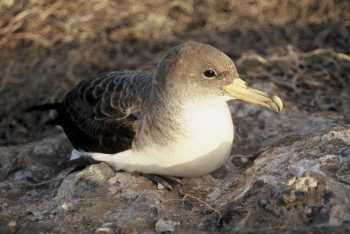Carlos Silva has been awarded a Master’s degree for his study of control methods for alien plants on an islet in the Azores that block the entrances to burrows of Cory’s Shearwaters Calonectris borealis.
The English version of the thesis summary follows:
“The introduction of alien species on the islands is a threat to the breeding seabirds. In some islands in the Azores, the alien flora reduces the potential area of breeding habitat for the Cory's Shearwater Calonetris [sic] diomedea Cory. In order to understand the problem 10 invasive aliens species was mapped with photo-interpretation techniques. The non-native, invasive giant reed Arundo donax is the most representative species and covers 28% of Vila Franca do Campo Islet (Azores). It blocks the entrance of Cory’s shearwater nest burrows and out-competes threatened the Azorean endemic flora. Three A. donax control methods were tested in 90 square meter plots, and a cost-effectiveness was determined using a Simple Additive Weighting Model. The most effective control method was cutting and removal of giant reed stems followed by two glyphosate-based foliar herbicide applications (one in May and another in late October i.e. corresponding to before and after the Cory’s shearwater breeding cycle). After one year, 92% of giant reed was controlled at an estimated cost of 0,66€ per square meter. This most cost-effective method was applied to 1,35 hectares of the islet. One year after the A. donax control the colonization of the vegetation on the study site was studied and monitored. A set of 19 square meter plots was deployed randomly and they were monitored three times from October 2010 to June 2011 (Autumn, Winter and Spring). It was recorded the vegetation cover rate and the maximum height of each species. Across the monitored season, 27 species have been identified (6 natives, 4 non-native invasives and 17 non-native). The non-native plants are the most representative group of plants with highest average of cover rate (0.4094 m²) and number of species. The native plants are the group less representative and have the lowest vegetation cover. The non-native invasive plants are the second most representative group of plants with a average of cover area of 0.1498 m² and, at the same time, have the highest records of maximum height (40.75 cm). Comparing all invasive species, statistical differences on vegetation cover and maximum height between the giant reed and the other invasive species were found. Throughout the monitored season positive and negative trends on the vegetation cover were detected (positive trends for non native and negative trends for non-native invasive). However these trends were not found to be statistically different. The data collected helps to define strategies and a set of actions required to achieve the goals of the restoration. The giant reed is still the target species, but these goals should be swift in order to prevent the spread of other extremely invasive species. It is recommended that chemical and manual control for these plants is used.”

Cory's Shearwater, photograph by Paulo Catry
Reference:
Silva, C.M.N. 2014. Restauração ecológica do ilhéu de Vila Franca do Campo, Açores: a recuperação do habitat para as aves marinhas. Master of Technology and Sustainability of Forest Systems, School of Agriculture, Polytechnic Institute of Castelo Branco.
John Cooper, ACAP Information Officer, 29 August 2014

 English
English  Français
Français  Español
Español